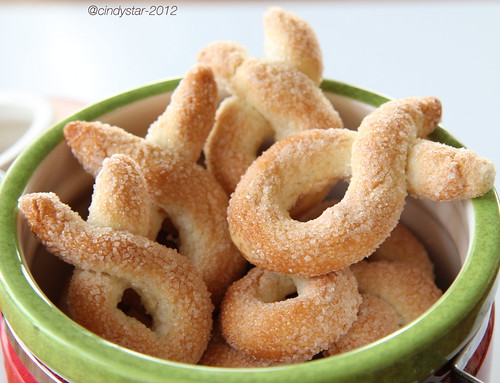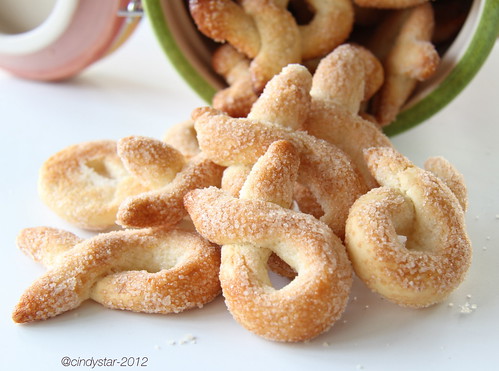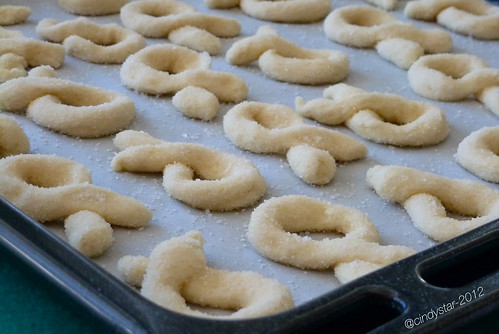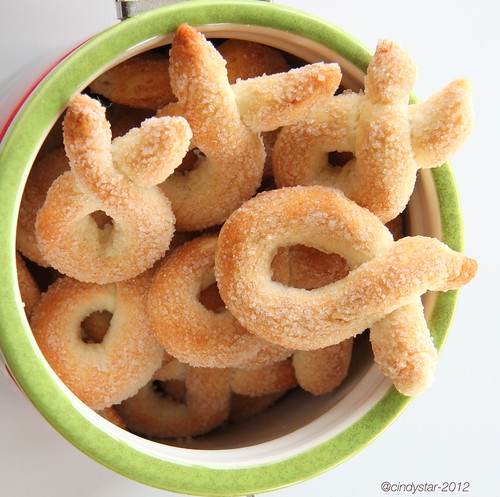Saint-Vincent Torcetti (twisted cookies)
la ricetta in italiano qui
Very friable cookies, ideal for afternoon tea, with a pretty high dose of butter but without sugar in the dough. Very common in Valle d'Aosta, a small mountainous region in North-Western Italy.
If stored in an airtight box, these cookies will keep well for several months ... if you manage to resist for so long!
For about 80 cookies:
- 500 g all-purpose flour
- 7 g dry yeast
- 200 g very soft butter
- warm water, about 300 g
- granulated sugar
- a pinch of salt
- buttered and floured baking tray (or use parchement paper)
Dissolve yeast in warm water.
Put flour and salt in a large bowl, make a well in the center and gradually add the water with the yeast, and begin to knead.
Turn over the dough on work surface and continue kneading until dough is smooth and elastic, if necessary add a little more water (but don't use it all if the dough does not require it). Shape into a ball and place in a buttered bowl, cover with plastic wrap and let rise in warm place for an hour or until doubled.
Gently transfer the dough onto the working surface and knead in the butter for about ten minutes, until well amalgamated, then let rest for another hour in the bowl as above.
I incorporated the butter by adding 50 g at a time and kneading until completely absorbed: stretch out the dough like a pizza, spread butter, roll up as to make a loaf and then knead. It takes a little patience, but eventually you will have a soft and quite manageable dough. And it is a super softening beauty mask for your hands :-).
Of course, helping with a stand mixer will save you a lot of work, but still knead for long.
Work the dough quickly, then take a little piece of dough and roll into a thin stick about 4 or 5 inches long, dip in sugar and then shape into oval bagel, joining the ends (I made a mistake and crossed over the two, but you should do as for taralli).
Place cookies onto the baking tray (buttered and floured or lined up with parchement paper) and bake at 200° for about 10/15 minutes, depending on size, until nice golden. Remove from oven and let cool before serving.
I had some burnt cookies on the bottom, because the sugar caramelized too much (I was using a new oven and still not much confident with it :-): do not worry, once cool just gently grate on a cheese grater (suitably clean and odorless :-), they will get as perfectly baked!
Put flour and salt in a large bowl, make a well in the center and gradually add the water with the yeast, and begin to knead.
Turn over the dough on work surface and continue kneading until dough is smooth and elastic, if necessary add a little more water (but don't use it all if the dough does not require it). Shape into a ball and place in a buttered bowl, cover with plastic wrap and let rise in warm place for an hour or until doubled.
Gently transfer the dough onto the working surface and knead in the butter for about ten minutes, until well amalgamated, then let rest for another hour in the bowl as above.
I incorporated the butter by adding 50 g at a time and kneading until completely absorbed: stretch out the dough like a pizza, spread butter, roll up as to make a loaf and then knead. It takes a little patience, but eventually you will have a soft and quite manageable dough. And it is a super softening beauty mask for your hands :-).
Of course, helping with a stand mixer will save you a lot of work, but still knead for long.
Work the dough quickly, then take a little piece of dough and roll into a thin stick about 4 or 5 inches long, dip in sugar and then shape into oval bagel, joining the ends (I made a mistake and crossed over the two, but you should do as for taralli).
Place cookies onto the baking tray (buttered and floured or lined up with parchement paper) and bake at 200° for about 10/15 minutes, depending on size, until nice golden. Remove from oven and let cool before serving.
I had some burnt cookies on the bottom, because the sugar caramelized too much (I was using a new oven and still not much confident with it :-): do not worry, once cool just gently grate on a cheese grater (suitably clean and odorless :-), they will get as perfectly baked!
Some information about Valle d'Aosta from Wikipedia:
It is a small mountainous region in North-Western Italy, bordered by Rhône-Alpes, France to the west, Valais, Switzerland to the north and the region of Piedmont to the south and east.
It is the smallest, least populous, and least densely populated region of Italy.
The native population speaks Valdôtain, a form of Franco-Provençal (Arpitan), as their first language, while in the Lys Valley there is a Walser German speaking minority. The regional capital is Aosta.
The cuisine of the Aosta Valley is characterized by simplicity and revolves around "robust" ingredients such as potatoes, polenta, and rice, cheese and meat and rye bread. Many of the dishes involve Fontina, a cheese with PDO status, made from cow's milk that originates from the valley. It is found in dishes such as a soup a la valpellinentse. Other typical local cheese are Toma and Robiola. Valle d'Aosta Fromadzo is produced locally since the 15th century and also has PDO status.
Regional specialties, besides Fontina, are mochetta (dried chamois meat, prepared like prosciutto), Vallée d'Aoste Lard d'Arnad (a cured and brined fatback product with PDO designation), Vallée d’Aoste Jambon de Bosses (a kind of ham, likewise with PDO designation), and a black bread. Notable wines include a white wine from Morgex, a red wine blend from Arvier (Enfer d'Arvier), and a Gamay.
Notable dishes include Carbonada, consisting of salt-cured beef cooked with onions and red wine served with polenta; breaded veal cutlets called costolette;tetouns, salt-cured cow's udder that is cooked and sliced; and bistecca a la valdostana, a steak with croutons and melted cheese.
It is the smallest, least populous, and least densely populated region of Italy.
The native population speaks Valdôtain, a form of Franco-Provençal (Arpitan), as their first language, while in the Lys Valley there is a Walser German speaking minority. The regional capital is Aosta.
The cuisine of the Aosta Valley is characterized by simplicity and revolves around "robust" ingredients such as potatoes, polenta, and rice, cheese and meat and rye bread. Many of the dishes involve Fontina, a cheese with PDO status, made from cow's milk that originates from the valley. It is found in dishes such as a soup a la valpellinentse. Other typical local cheese are Toma and Robiola. Valle d'Aosta Fromadzo is produced locally since the 15th century and also has PDO status.
Regional specialties, besides Fontina, are mochetta (dried chamois meat, prepared like prosciutto), Vallée d'Aoste Lard d'Arnad (a cured and brined fatback product with PDO designation), Vallée d’Aoste Jambon de Bosses (a kind of ham, likewise with PDO designation), and a black bread. Notable wines include a white wine from Morgex, a red wine blend from Arvier (Enfer d'Arvier), and a Gamay.
Notable dishes include Carbonada, consisting of salt-cured beef cooked with onions and red wine served with polenta; breaded veal cutlets called costolette;tetouns, salt-cured cow's udder that is cooked and sliced; and bistecca a la valdostana, a steak with croutons and melted cheese.
This recipe is also my entry to this week Susan's YeastSpotting.

















5 commenti:
Elo, grazie a te per la raccolta! :-)
Avanti con la B!
Delicious and lovely photos!
Thank you, Lynne :-)
buonissimi questi biscotti.
Linda, devo rifarli perchè sono spariti in un lampo :-) ... qua non dura niente! :-)
Posta un commento
grazie della visita e gentilmente firma sempre i tuoi commenti!
thanks for passing by and please sign up your comments!